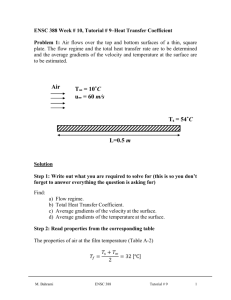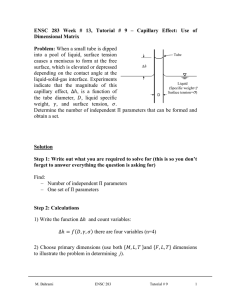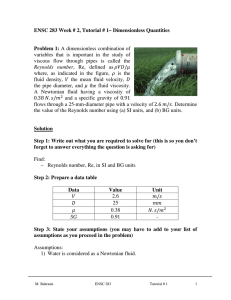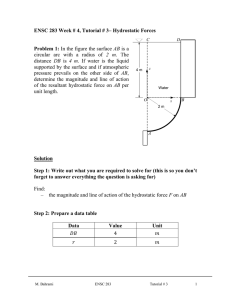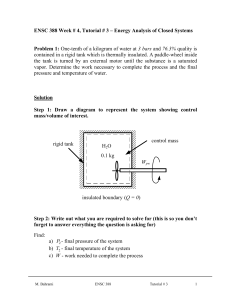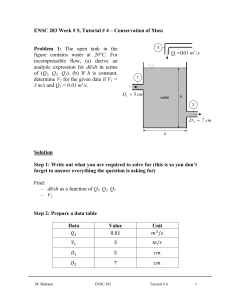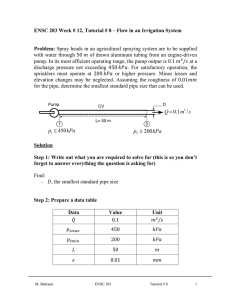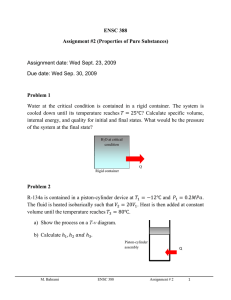ENSC 388 Week # 10, Tutorial # 9–Heat Transfer Coefficient
advertisement
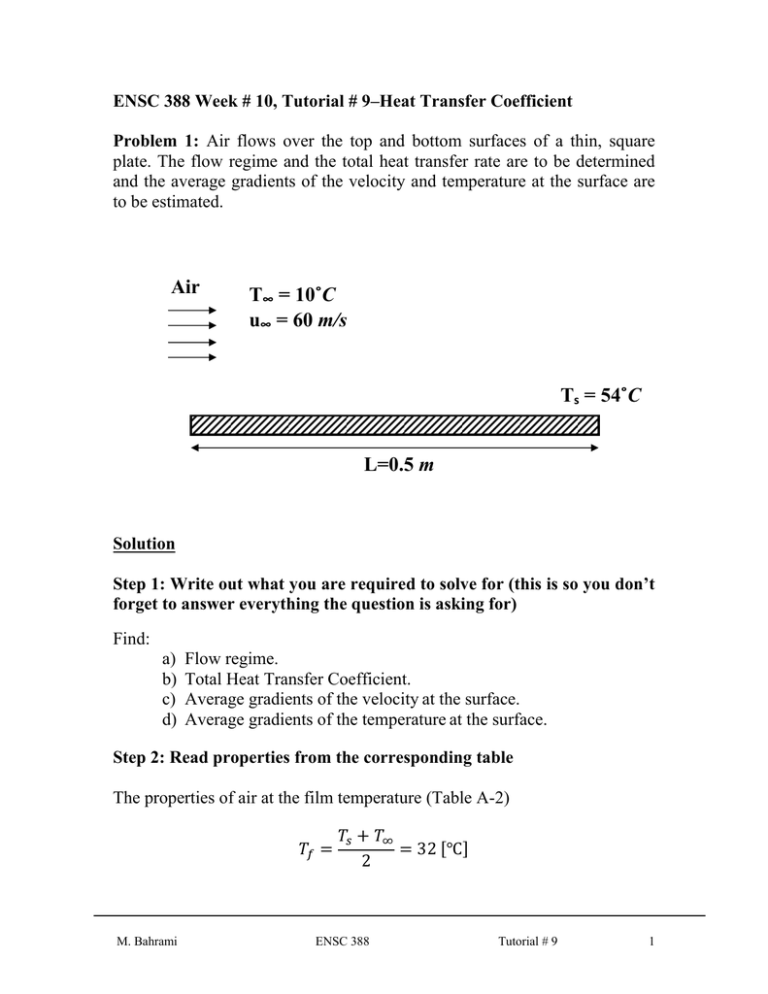
ENSC 388 Week # 10, Tutorial # 9–Heat Transfer Coefficient Problem 1: Air flows over the top and bottom surfaces of a thin, square plate. The flow regime and the total heat transfer rate are to be determined and the average gradients of the velocity and temperature at the surface are to be estimated. Air T∞ = 10˚C u∞ = 60 m/s Ts = 54˚C L=0.5 m Solution Step 1: Write out what you are required to solve for (this is so you don’t forget to answer everything the question is asking for) Find: a) b) c) d) Flow regime. Total Heat Transfer Coefficient. Average gradients of the velocity at the surface. Average gradients of the temperature at the surface. Step 2: Read properties from the corresponding table The properties of air at the film temperature (Table A-2) 2 M. Bahrami ENSC 388 32 Tutorial # 9 1 ρ = 1.156 1.007 υ = 1.627 × 105 k = 0.02603 Pr = 0.7276 Step 3: State your assumptions (you may have to add to your list of assumptions as you proceed in the problem) Assumptions: 1) Steady operating conditions exist. 2) The critical Reynolds number is Recr = 5105. 3) Radiation effects are negligible. Step 4: Calculations (a) The Reynolds number is Re L VL (60 m/s)(0.5 m) 1.844 10 6 2 5 1.627 10 m /s which is greater than the critical Reynolds number. Thus we have turbulent flow at the end of the plate. (b) We use modified Reynolds analogy to determine the heat transfer coefficient and the rate of heat transfer s Cf s 0.5V Cf 2 M. Bahrami 2 F 1.5 N N 3 2 2 A 2(0.5 m) m 3 N/m 2 3 0.5(1.156 kg/m )(60 m/s) St Pr 2 / 3 2 1.442 10 3 Nu L Nu L Pr 2 / 3 Re L Pr Re L Pr 1 / 3 ENSC 388 Tutorial # 9 2 (1.442 10 3 ) Nu Re L Pr (1.844 10 )(0.7276) 1196 2 2 0.02603 W/m.C k W (1196) 62.26 2 h Nu 0.5 m L m C Q hAs (Ts T ) (62.26 W/m 2 C)[2 (0.5 m) 2 ](54 10)C = 1370 [W] 1/ 3 Cf 6 1/ 3 (c) Assuming a uniform distribution of heat transfer and drag parameters over the plate, the average gradients of the velocity and temperature at the surface are determined to be s u u 3 N/m 2 1.60 10 5 [s -1 ] s 5 3 2 y 0 y 0 (1.156 kg/m )(1.627 10 m /s) k h T y 0 Ts T M. Bahrami T y 0 h(Ts T ) (62.26 W/m 2 C)(54 10)C C 1.05 10 5 k 0.02603 W/m C m ENSC 388 Tutorial # 9 3 Problem 2: The wind is blowing across the wire of a transmission line. The surface temperature of the wire is to be determined. Wind Transmission Wire / . Solution Step 1: Write out what you are required to solve for (this is so you don’t forget to answer everything the question is asking for) Find: a) Surface temperature of the wire. Step 2: Read properties from the corresponding table We assume the film temperature to be 10C. The properties of air at the film temperature (Table A-2) ρ = 1.246 υ = 1.426× 10−5 k = 0.02439 Pr = 0.7336 M. Bahrami ENSC 388 Tutorial # 9 4 Step 3: State your assumptions (you may have to add to your list of assumptions as you proceed in the problem) Assumptions: 1) 2) 3) 4) Steady operating conditions exist. Radiation effects are negligible. Air is an ideal gas with constant properties. The local atmospheric pressure is 1 atm. Step 4: Calculations The Reynolds number is Re u D (40 1000/3600) m/s(0.006 m) 4675 1.426 10 5 m 2 /s The Nusselt number corresponding to this Reynolds number is determined to be 0.62 Re 0.5 Pr 1 / 3 hD Nu 0.3 1/ 4 k 1 0.4 / Pr 2 / 3 Re 5 / 8 1 282,000 4/5 5/8 0.62(4675) 0.5 (0.7336)1 / 3 4675 1 0.3 2 / 3 1/ 4 282 , 000 1 0.4 / 0.7336 4/5 36.0 The heat transfer coefficient is h k 0.02439 W/m.C W Nu (36.0) 146.3 2 D 0.006 m m C The rate of heat generated in the electrical transmission lines per meter length is W Q I 2 R (50 A) 2 (0.002 Ohm) = 5.0 [W] M. Bahrami ENSC 388 Tutorial # 9 5 The entire heat generated in electrical transmission line has to be transferred to the ambient air. The surface temperature of the wire then becomes As DL (0.006 m)(1 m) = 0.01885 [m 2 ] Q 5W Q hAs (Ts T ) Ts T 10C + 11.8 [C] 2 hAs (146.3 W/m .C)(0.01885 m 2 ) M. Bahrami ENSC 388 Tutorial # 9 6
